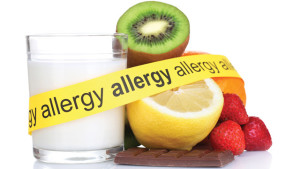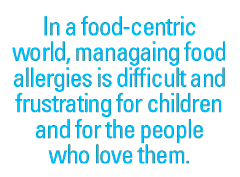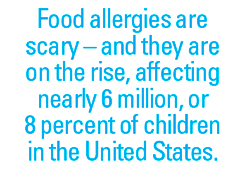The Dangerous, Bothersome, and Common Health Issue
By Joan Tupponce
 Tiffany Ferreira couldn’t understand why the eczema on her 4-month-old son’s face wouldn’t go away back in 2007. The Chesterfield County resident thought it might be acne, but it continued to worsen. She scoured the Internet and after much searching discovered that eczema can be caused by a milk allergy. She called her pediatrician with the findings.
Tiffany Ferreira couldn’t understand why the eczema on her 4-month-old son’s face wouldn’t go away back in 2007. The Chesterfield County resident thought it might be acne, but it continued to worsen. She scoured the Internet and after much searching discovered that eczema can be caused by a milk allergy. She called her pediatrician with the findings.
“Our pediatrician thought it was all in my head,” says Ferreira who decided to take action on her own. “I was nursing, so I stopped eating things with milk.”
Two months later, at the advice of the doctor treating her son, Charlie, for a cold, Ferreira fed him yogurt. He broke out in hives. But still, no one seemed too concerned, no one except Ferreira and her husband.
On his first birthday, Charlie was eating a cupcake when he had an anaphylactic reaction. The most severe allergic reaction, anaphylaxis is a life-threatening whole-body allergic reaction that can impair your breathing, cause a dramatic drop in your blood pressure, and affect your heart rate. “I didn’t realize what was happening,” Ferreira says, noting that the egg in the cupcake turned out to be the culprit. “My friend, who is a nurse, said he was having an allergic reaction.”

1603_Allergies_call1Based on Charlie’s reaction, the pediatrician recommended blood testing for food allergies. The test showed that Charlie couldn’t have eggs, milk, peanuts, wheat, or soy. A while later, allergy skin tests revealed that he was not allergic to peanuts, wheat, or soy. The allergist concluded the original blood test had produced false-positive results on those specific foods.
Now eight, Charlie lives with three food allergies: eggs, milk, and tree nuts. When he was three-and-a half, he had an anaphylactic reaction to cashews, a shock because he had been eating almond butter with no problem. This is where it’s important to note that just because an initial reaction causes few problems (that might even go undetected) doesn’t mean all reactions will be similar. Particularly scary for parents of kids who have food allergies, a food that triggered only mild symptoms on one occasion may cause more severe symptoms at another time.

“Food allergies can occur at any age, even in infants a few days old,” says Andrew Kim, MD, of the Allergy & Asthma Center of Fairfax. “The prevalence of food allergies is higher in children. Sometimes you can develop new allergies to something you previously tolerated. It can happen all of a sudden. The older you get, the less likely it is.”
Most food allergies are related to peanuts, tree nuts, milk, eggs, fish, shellfish, wheat, and soy. Cow’s milk, egg, and soy allergies typically begin in childhood and eventually may be outgrown according to Food Allergy Research & Education (FARE). In the past, most children outgrew these allergies by school age, but a recent study from Johns Hopkins University School of Medicine showed that children are taking longer to outgrow milk and egg allergies, with the majority becoming allergy-free by age sixteen.
The most common symptoms of food allergies include skin symptoms such as atopic dermatitis, rashes, hives, or swelling minutes after ingesting a food. Other symptoms include palpitations, gastrointestinal issues, vomiting, throat tightness, wheezing, trouble breathing, paleness, confusion, and loss of consciousness.

The tests showed that Abigail was allergic to dairy, egg, tree nuts, and peanuts. Initially she was able to eat shellfish, but in the last few years she has developed that allergy as well. Bridges’ youngest daughter, Olivia, four, is also allergic to eggs. “We got Olivia tested before we transitioned to table food,” Bridges says.
Bridges and his wife make Abigail’s lunches every day “because she can’t eat anything at the school cafeteria,” Bridges says. “At a young age, we had to teach her that she couldn’t have certain foods and she can’t have anything she hasn’t had previously. We always have apprehensions that someone will give her something she can’t have.”
Parents who suspect a food allergy should talk to their doctor. “Most of the time, when a family believes their child has a food allergy, it will end up that the child does not,” says Scott Sicherer, MD, a professor of pediatrics, allergy and immunology at Jaffe Food Allergy Institute, Icahn School of Medicine at Mount Sinai in New York. “They could have a rash or hives for some other reason. A lot of things can cause the same symptoms.”
If symptoms are suspicious, the doctor may send you to an allergist for testing. Allergists will either do a skin test, a blood test, or a combination of both to determine what allergies are present. “The skin test can be done quickly and the results are quick,” says Dr. Kim. “You can miss more true allergies with a blood test, and it can be hard to get a blood draw, but each test has its advantages and disadvantages.”
The main defense against food allergies is food avoidance, but trying to determine the ingredients in foods can be frustrating. When you are shopping, always check the label to make sure there are no allergens on the list. Most labels will also list offending allergens at the bottom after the ingredients with a line like, This contains milk and soy.
Sending a child to school with food allergies can be scary for parents. It was for Goochland resident Theresa Green whose son, River, 11, has peanut and tree nut allergies. “They have a special table at school for children with allergies, but I don’t want him to be excluded from friends,” she says. “He sits at the end of the regular table. He has to make sure the kids around him don’t have nuts. I feel like he needs to learn how to maneuver in life with a food allergy. This helps him prepare for it.”
When River started school, Green considered ways to keep her son safe. She began making t-shirts that sported trendy food allergy warning designs. Today, allergyapparel.com, her online company, carries t-shirts and EpiPen holders, as well as jewelry, targeted to families with preschoolers.
While many children and adults with food allergies keep EpiPens, or similar devices to deliver auto-injectable epinephrine, with them at all times, parents should be somewhat relieved to know that all schools in Virginia are required to have non student-specific doses of epinephrine on-site in the event of an allergic reaction. The legislation was passed and signed into law in 2012. “Education has come a long way,” says Rishi Bala, MD, of Bon Secours Sports Medicine and Primary Care at the Bon Secours Washington Redskins Training Center. “You have to recognize the symptoms. If you have severe reactions, you should also have an EpiPen at home or with you, along with an antihistamine.” Once an anaphylactic reaction starts, epinephrine is the first line of defense to treat the reaction, but it’s important to seek emergency medical attention by calling 9-1-1.
For families, school isn’t the only situation that causes apprehension. Eating out can be difficult as well. “We are okay with meat and vegetables, but it’s gotten to the point where Abigail doesn’t want to eat grilled chicken or hamburger,” says Bridges. “She gets tired of having to have the same thing.”
As part of her ongoing research, Ferreira has been following House Bill HB 2090, which was passed in the 2015 General Assembly and signed by Governor McAuliffe. The bill requires food-allergy training for restaurant staff. “I’m interested to see how that will impact our ability to eat out,” says Ferreira. “I am interested in finding those restaurants that embrace the opportunity to make safe food.”

1603_Allergies_call2Bridges, who often travels to Walt Disney World Resort with his family, finds that restaurants at the resort are versed in feeding families with kids who have food allergies. “Disney goes above and beyond when it comes to that,” he says.
In 2011, Walt Disney Parks and Resorts was given an award by the Food Allergy and Anaphylaxis Network (FAAN) for recognizing that “families with food allergies deserve to feel safe while on vacation.” Restaurants at both Walt Disney World and Disneyland offer allergy-friendly menus. The parks also offer the option to consult directly with a Disney chef.
Instead of eating out, Ferreira and her family have opted to “go back to the basics and make simply cooked foods,” she says. “There is not a lot of going out and eating fast food. The silver lining is that we plan meals and we eat around the table.”
She finds there is a growing market for products without allergens. “Every time I go into the grocery store, there is a new product,” she says. “We read what’s on the label to be accurate. You need to know what’s in there. We have trusted brands like Enjoy Life mixes.”
Researchers continue to work on therapies to help with food allergies, and some of that research, for example, oral immunology, is showing positive results. “That is where you introduce what you are allergic to orally and your body becomes sensitized after a certain amount of doses,” says Dr. Bala. “It looks like it’s going to be the next therapy.”
One recent study may change the way doctors approach peanut allergies. In the past, doctors have suggested deferring the introduction to highly allergenic foods until a child is three years old. But the Learning Early About Peanut Allergy (LEAP) study, funded by Food Allergy Research & Education (FARE) and the National Institute of Allergy and Infectious Diseases (NIAID), part of the National Institutes of Health, found that “kids who avoided peanuts had more allergies than kids who were introduced to them at a younger age,” says Dr. Kim.

Food intolerance such as lactose intolerance is based on the food itself. It can cause gastrointestinal symptoms because your body lacks the enzyme needed. Food sensitivities can also cause gastrointestinal issues and dermatitis.
Much is written about the basics of food allergies, but kids and their parents also have to live with the social side of the health issue. “Kids will make comments,” says Bridges. “Usually Abigail does a great job dealing with it, but when she might have an issue is when she can’t be included in something. They did a craft the other day, for example, and made an ice cream cone with icing. She was left out of the craft activity because she was allergic to the icing. That’s the most frustrating thing, when she gets excluded from activities at school. If we know in advance, we can plan for it.”
In a food-centric world, this can be difficult for children and the people who love them. Ferriera’s son, Charlie, simply wants to blend in with what the other kids are having, she says. “He wants to be a normal kid. The social side is the hardest.”
